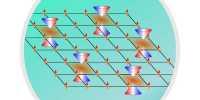Researchers have literally reversed this principle. And it still works. One of the oldest laws of physics is the Archimedes principle. It describes the ward upward buoyant ball that takes on a body when it is submerged in a liquid.
French researchers were curious about the behavior of liquid boundaries and therefore tried to understand what things were in terms of the price of liquids. To trap the liquid, the team used a method known as vertical vibration. By dipping air bubbles in glycerol or silicone oil and then shaking the container vertically, it is possible to create a thick liquid float in less dense air. It is also possible to create multiple layers of levitating fluid.
If the liquid is made for levitation, boats can float on both surfaces, doing so in contrast to gravity at the bottom, Reported as Nature. Counter-intuitive scenarios allow researchers to better examine the properties of levitating fluids. They established that the floating power at the bottom depends on the mass of the floating object. Exceeding a certain limit, they end up “drowning” in the air below.
This method has been well established and researchers have been surprised by the strange phenomenon they have witnessed. The most mind-boggling discovery so far was that suspended-level air bubbles could sink rather than rise. The party has taken it one step further and shown that the talk of heavy bodies is in fact an electoral collapse. They don’t just sink to the bottom of the container. A reverse floating force similar to the Archimedes principle works in bodies even downwards.
The team uses half a liter of liquid with a maximum width of 20 centimeters (7.9 inches). These liquids float on both surfaces if up to 7 surfaces and 2.5 centimeters (about 1 inch). The reverse-float only worked when the system oscillated tens of times per second, in the experiment.
The team believes that the test setup is the key to pulling the antigravity of the liquid in the little boat and explaining the different people tested in the study. In an elevator, you can experience an effective gravity depending on whether it is going up or down, whether it is higher or lower than the gravitational pull of the earth depending on the direction of travel. A free lift can make you feel like floating.
This creates a push, rather than a gravitational anti-gravitational pull, which keeps objects from overflowing instead of falling. The same forces are playing here. The rapid oscillation keeps the liquid floating. Except for the very great video, the potential applications of this study could go beyond physics. High-frequency excitation systems are found in biology and chemistry, and counter-intuitive phenomena can also be found there.















